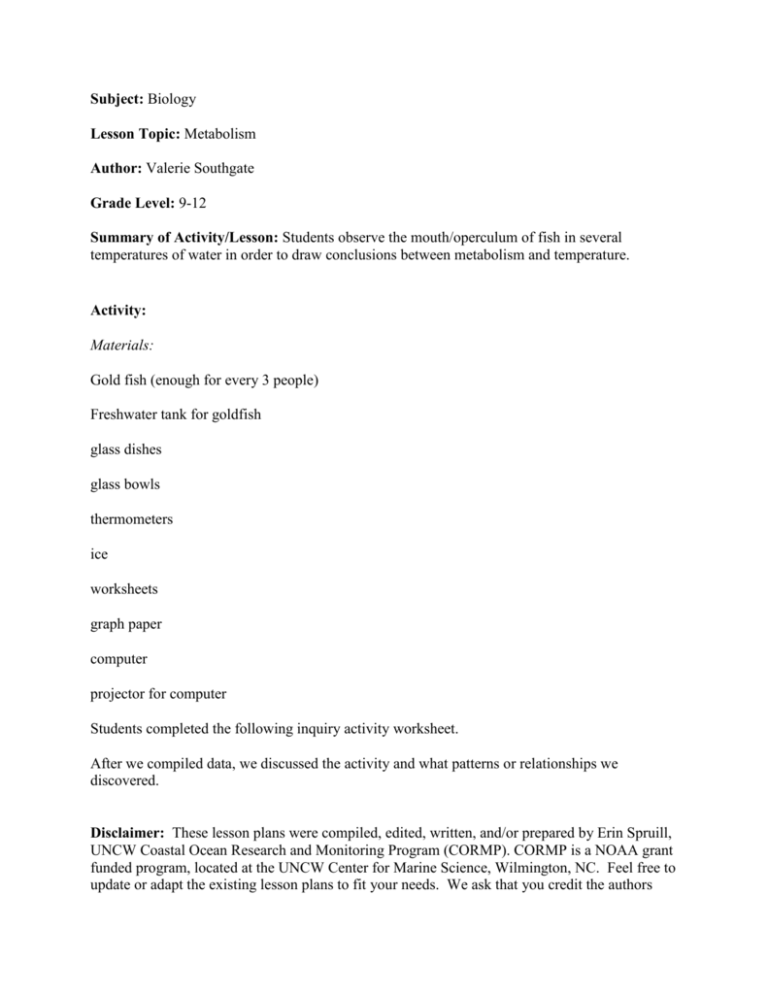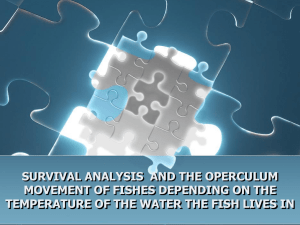Author: Valerie Southgate
advertisement

Subject: Biology Lesson Topic: Metabolism Author: Valerie Southgate Grade Level: 9-12 Summary of Activity/Lesson: Students observe the mouth/operculum of fish in several temperatures of water in order to draw conclusions between metabolism and temperature. Activity: Materials: Gold fish (enough for every 3 people) Freshwater tank for goldfish glass dishes glass bowls thermometers ice worksheets graph paper computer projector for computer Students completed the following inquiry activity worksheet. After we compiled data, we discussed the activity and what patterns or relationships we discovered. Disclaimer: These lesson plans were compiled, edited, written, and/or prepared by Erin Spruill, UNCW Coastal Ocean Research and Monitoring Program (CORMP). CORMP is a NOAA grant funded program, located at the UNCW Center for Marine Science, Wilmington, NC. Feel free to update or adapt the existing lesson plans to fit your needs. We ask that you credit the authors and editors of these activities. In addition, please contact us with new methods and activities you implement in the classroom. Continual collaboration and revision will allow us to provide educators with the most useful and current resources for classroom use. Thank you. Name: TEMPERATURE AND METABOLISM: Respiration Rate of a Fish Purpose: To observe the effect that temperature of the environment has in the metabolic rate of a fish. Materials: Gold fish (from pet store) Container to restrict fish Bowl or container (for ice bath into which the fish container is placed) Thermometers Ice Fresh water Procedure and Observations: Answer the questions in italics as you go through the lab! 1. Put a fish into a movement-restricting container with enough water to cover the dorsal din but small enough to restrict movement and to allow observation. 2. Observe the movements of the operculum (gill cover) and mouth. How do the movements of the mouth and operculum coordinate? 3. Place the beaker containing the fish into the bowl. Place a thermometer at the edge of the fish container so that is can be read without disturbing the fish. Slowly and carefully add ice to the bowl to make an ice bath. Reduce water temperature to about 5°C. 4. Observe the movement of the operculum. Count the movement of the operculum for one minute at this temperature and record this count in the data table on the back of this worksheet. 5. Remove the ice from the bowl. Slowly add warmer water down the side of the fish container opposite that of the thermometer. Create a system of removing water to keep the container from overflowing. Why is it important to keep from exciting the fish? 6. Closely observe the thermometer and continue adding warmer water until a 3°C rise in temperature is noted. Allow time for the fish to adjust to the temperature change. 7. Count and record the number of operculum movements at each 3 degree temperature internal until temperature reaches 23°C. 8. Using graph paper, graph the operculum movement rate vs. temperature for your group’s fish. Be sure to label the x and y axis of your graph and give the graph an appropriate title!! 9. Obtain the class data from the other groups. Compute the average operculum counts for each temperature noted. On the same graph, plot the class average values for the operculum movement rate vs. temperature.








